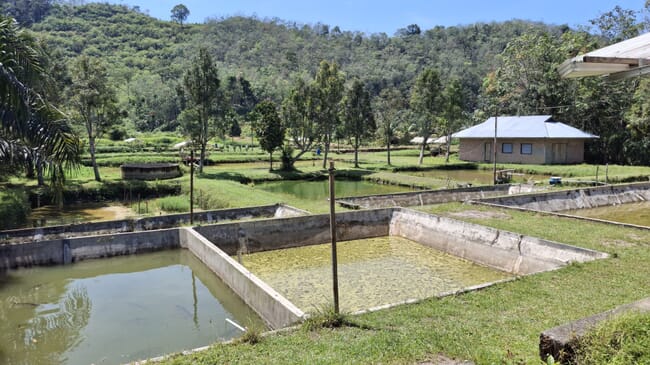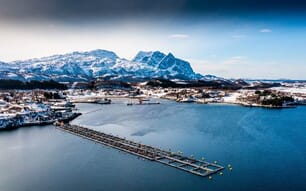
After being relocated in the 1990s due to the construction of a hydroelectric power plant, the community now living in Koto Mesjid, XIII Koto Kampar, Riau, came close to falling into poverty. They were given cash compensation and rubber plantations, but the money quickly ran out and the plantations failed to be profitable. Thankfully, in the early 2000s, the community was introduced to fish farming, which has since become their main source of income.
It was Suhaimi, one of the most influential villagers, who introduced fish farming and became a role model for the community. As a technical officer at the local Agricultural Technology Agency (BPTP) at the time, he recognised the untapped potential for aquaculture, and shortly after the turn of the century, he began conducting studies to identify the most promising species for the area.
Taking into account factors such as ease of cultivation, the suitability of the site, the production costs, market potential and ease of processing, the community ultimately chose to cultivate pangasius.
“The soil here is also quite ideal for pangasius – firm and not porous. Sandy clay retains water well. Pangasius can grow with relatively little water, but these soil conditions help stabilise water content, which is beneficial for production efficiency,” he explains.
Seeing the potential, Suhaimi decided to leave his job as an officer at BPTP and become a full-time farmer, while also aiming to build a wider farming ecosystem there.
“At first, I was the only one farming fish here. Now, the whole community is involved. Our daily production has reached 15 tonnes, thanks to the 160 hectares of fish ponds we now have in Kampung Patin. As a result, our economy is strong, education levels have improved and social life is thriving because prosperity is shared evenly here,” he says.
Around 600 of the 700 households in the village are now engaged across the pangasius farming value chain, giving rise to the phrase Tiada rumah tanpa kolam – “No home without a fish pond.”
With these resources, the community produces 5,000–6,000 tonnes of pangasius annually. Economically, the impact is significant: the average monthly household income now ranges from IDR 7-10 million – roughly twice the country’s minimum wage.

Breaking through the challenges
The first major factor that made fish farming promising in the village was the discovery of an underground water source, 90 metres beneath the ground.
"The water is clear, fresh and pristine, and we use it directly without any treatment. We pump the water with an electric machine. It may sound expensive at first, but once we consider the overall operational expenses, it's actually quite reasonable," Suhaimi explains.
In terms of seed supply, most of the village’s pangasius larvae were initially imported from Java, but the long distance transport increased their cost and reduced their quality. To solve this, Suhaimi set up a hatchery and began producing his own larvae using quality broodstock, which he purchased from government centres, using proper hatchery facilities and technology. Suhaimi’s hatchery has since flourished, and other villagers have also established their own.
“Currently, there are eight hatcheries operating here, producing 3.5 million fry each month. I personally produce 600,000 of them. At times, this amount is sufficient to meet local demand, but other times it falls short. When that happens, we buy from outside the village. On the other hand, if production exceeds demand, we sell the surplus to farmers beyond the village,” Suhaimi explains.

The same goes for feed, which accounts for 85 percent of production costs. The high price of commercial feed prompted farmers to make their own, using a simple mix of local ingredients such as fine rice bran, small fish and a bit of palm kernel meal. Although the homemade feed leads to slower growth, longer cultivation cycles and higher feed conversion ratios (FCRs), Suhaimi insists the practice remains economical.
As he explains, local homemade feed costs only IDR 5,600/kg – about half the price of commercial feed – so the production cost of pangasius per kilogram of local feed is around IDR 12,000, while with commercial feed it reaches IDR 14,500/kg. With an average selling price of IDR 18,500, using homemade feed provides greater profitability. According to Suhaimi, commercial feed is typically reserved for broodstock to ensure optimal nutrition.
Just as important, producing feed locally provides jobs and keeps money circulating in the village.
“We have 38 homemade feed factories with a total production capacity of 35-40 tonnes per day. This is a huge help to the farmers here,” he reflects.
Unlocking added value
Community innovation goes beyond the farm itself – realising that traditional markets were not giving fair prices for their fresh fish, the villagers now process about 80 percent of their fish themselves, mainly by smoking them, while the remaining 20 percent is sold locally and outside the city.
“We’ve tried to build our own market. The smoked fish industry here currently processes around 12 tonnes of fish every day,” Suhaimi says.
This segment generates tremendous added value. Downstream businesses sell smoked fish at IDR 75,000 per kilogram, with a yield of 28–30 percent from fresh raw materials. The fish used as raw material typically weigh 150–200 grams, typically reaching this weight after just under 4 months.

Here a group of farmers from Cambodia have come to learn about the farming model
An edu-tourism model
Thanks to its unique identity as a Pangasius Village, the community has also tapped into its potential as an edu-tourism destination. According to Suhaimi, most visitors are students, farmers or aspiring farmers seeking to conduct comparative studies on pangasius farming.
One organisation benefiting is Banglele Indonesia, a consulting and education company in the aquaculture sector with an international audience. They selected Pangasius Village as a key site for their aquatourism programme.
“Kampung Patin is the perfect showcase for our participants, especially those from developing countries,” says Barkah Tri Basuki, founder of Banglele. “A recent group of aquaculture trainers from Cambodia was particularly impressed by the small-scale integrated aquaculture system here – especially the homemade fish feed, which they saw as a breakthrough in reducing costs.”
The success of the Pangasius Village in developing an integrated aquaculture offers an inspiring model that Suhaimi believes can be replicated elsewhere. According to him, the key lies in choosing the right species – one that fits local environmental conditions, uses farming technology that is easy for most people to adopt, and has a reliable market. Just as important, he adds, is the presence of someone who can set an example and provide leadership for the collective good.
Since most of the community is already involved and benefiting economically from the Pangasius Village, Suhaimi and his colleagues have no plans for major expansion beyond maintaining and improving what already exists. Even so, he remains open to new initiatives, whether from government or the private sector, that could bring further development to the village.

The village's feed mills also help to provide more jobs for the community




